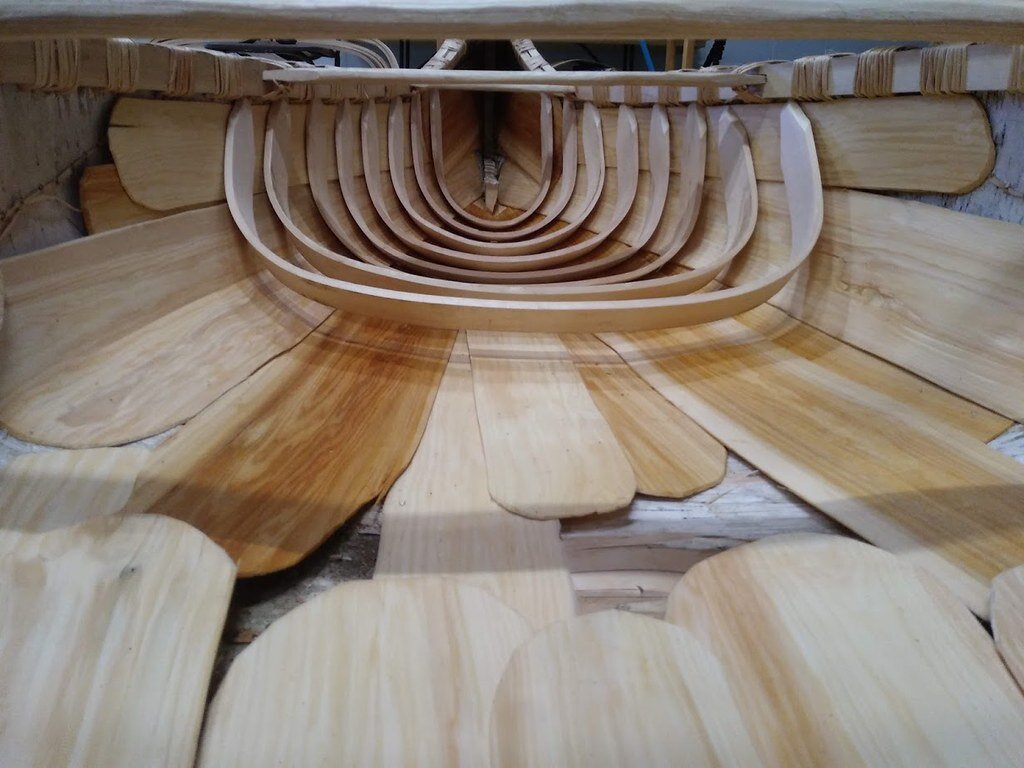Building a Canoe, Strengthening Guardianship
By: Amberly Quakegesic
December 18, 2020
Photos from the birch bark canoe building process with canoe master Chuck Commanda, and the Wahkohtowin Guardians. Photo: Kari Luhtasaari
As a Guardian with the Wahkohtowin Development Program, I was a part of a team that embarked on a journey to connect our community to culture by building a traditional Algonquin style canoe. I am filled with gratitude to have been a part of the entire process. From digging up roots in the ground to paddling the canoe on a river, it was a great Guardian project. Because it incorporated traditional knowledge, land-based learning, and reconnecting the youth with the Elders, I found connection and meaning in the journey, and in giving the process as long as it needed for just the right amount of learning to take place.
I also truly believe that although not everyone knows this yet, everyone wants to build a birch bark canoe. It is connected to who we are. To our cultural heritage. It feels so natural, so Canadian.
Canoe building process with canoe master Chuck Commanda. Photo: Kari Luhtasaari
The project began when our Program Manager, David Flood, met Chuck Commanda, a master canoe builder from Kitigan Zibi, Quebec. In August,Chuck travelled to our community and we spent time in the bush with him learning about the needed materials. He taught our Guardian team how to harvest birch bark, cedar, black ash, spruce roots and spruce gum. We got to know the land and learned to see it in a way that we had never seen it before. It was an empowering experience that helped me personally to reconnect with the land, my culture, and my ancestors.
Harvesting materials for the canoe. Photo: Amberly Quakegesic
Chuck says that “the canoe teaches us that we are all in this together and in order to move forward, we must work together.” The canoe was always an essential part of life for First Nations peoples because it was used as a vessel for livelihood, travel and trade. I couldn’t help but wonder throughout the process how different it would have been for our ancestors and what kind of tools they would have used. I was often presented with opportunities to wonder about their ways of living, the kinds of food they ate, and the overall purity of their lifestyles in general. This led me to wonder about how different the state of the air, waters, and lands used to be in. And that spurred thinking about my own values and beliefs. This canoe build gave me a lot of time for self-reflection and to gain awareness of the ever changing world that exists around me.
Inside of the canoe during construction. Photo: Kari Luhtasaari
This was important for my personal growth, but as a Guardian, one of our goals is also to change world views and assist people with embracing an Indigenous perspective. Especially our youth.
We have several projects that involve bringing youth out onto the land and helping them to reconnect with their culture and traditions. These include solar panel building and installation, a birch sugar shack, herbicide alternative survey work, outland youth camp with more to come. We want to increase efforts to have boots on the ground monitoring for plants, medicines and wildlife. This includes occurrence and abundance surveys for medicines and monitoring for moose emphasis area efficacy.
We try to do everything we can to empower youth so that they are more likely to continue their education, find employment, and give back to their home communities. Our Guardian Program helps in building confidence through skill development, working on the land, reconnecting with elders and helping them to find their pathway in this world.
The Wahkohtowin team launching the canoe on the Chapleau waterfront. Photo: Kari Luhtasaari
Although I will admit that when we first started building the canoe, I was nervous about the quality of our harvesting efforts since we did the majority of it on our own, I was also inspired and filled with confidence being surrounded by the knowledge of those building alongside me. There is a confidence that comes with teachings and experiences like this, to be surrounded by traditional knowledge keepers and to witness the finesse required to achieve such beautiful craftsmanship. I now feel connected to this canoe, I think our entire Guardians program does, knowing everything we used to build the canoe came from the forest.
This kind of traditional knowledge is so important because it is a form of lived expertise that can accumulate over a thousand years, of land and environmental knowledge that is linked with spirituality. It is passed on generationally to and from people who walked the land and learned to live it in a sustainable way. The earth provides everything we need and as stewards of the land, it is our duty to protect it. The Guardian program gives me hope because we are fighting for preservation of traditional knowledge, of our culture. We are fighting for a voice around the forestry management table. We are fighting climate change. We are educating youth, building capacity in our communities, and listening to our elders.
Amberly Quakegesic out on the water in the canoe with canoe master Chuck Commanda. Photo: Kari Luhtasaari
When the big day arrived, and it was time to launch the canoe, the community of Chapleau was very fascinated and came out to show their support! To help showcase our beautiful canoe launch, the Guardian team walked the canoe across Chapleau to the waterfront, where a small ceremony was held with singing and drumming. Overall, it truly was a rich experience for everyone who participated. Together we learned, we laughed, we shared, and connections were made to the land and with each other that will last a lifetime. Our goal is to help bring more youth out onto the land and share these teachings and experiences to help keep these beautiful traditions alive.






